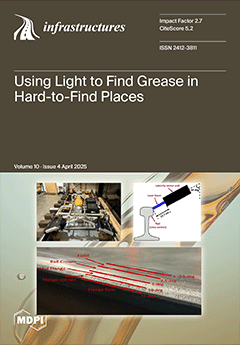In construction, closely spaced footings cause stress interactions that impact bearing capacity, settlement, and stability. This study experimentally evaluates the role of sheet pile walls (SPWs) in improving the performance of two adjacent strip footings—an existing footing and a newly placed footing—on sandy
[...] Read more.
In construction, closely spaced footings cause stress interactions that impact bearing capacity, settlement, and stability. This study experimentally evaluates the role of sheet pile walls (SPWs) in improving the performance of two adjacent strip footings—an existing footing and a newly placed footing—on sandy soil. The influence of SPW penetration depth (L
s) and center-to-center spacing between footings (X) on settlement and bearing resistance under vertical loads was investigated. Experiments were conducted in a large-scale soil tank (330 × 30 cm, depth 210 cm), with X ranging from 300 mm to 1000 mm and SPW lengths varying from 0 mm to 1500 mm. The results show that SPWs significantly enhance foundation performance by reducing settlement and increasing bearing capacity. When L
s/B = 6, the settlement of the new footing (F
1) decreases by 48%, while the existing footing (F
2) sees reductions of 47%, 67%, and 77% at L
s/B = 3, 4, and 5, respectively, under 500 kN/m
2 stress. The bearing capacity of F1 increases by 53% when X = 300 mm, demonstrating strong interference effects. Conversely, the F
2 settlement increases as X decreases, with a 96% rise at X = 300 mm, but it stabilizes at L
s/B = 5. SPWs also shift failure from general shear to punching shear, modifying soil–structure interaction. These findings highlight the effectiveness of SPWs in mitigating settlement, enhancing load-bearing capacity, and optimizing foundation design in closely spaced footing systems. The results suggest that an SPW length-to-footing width ratio (L
s/B) between 4 and 5 is optimal for minimizing settlement and improving stability, with only a slight difference in effectiveness between these two ratios.
Full article





